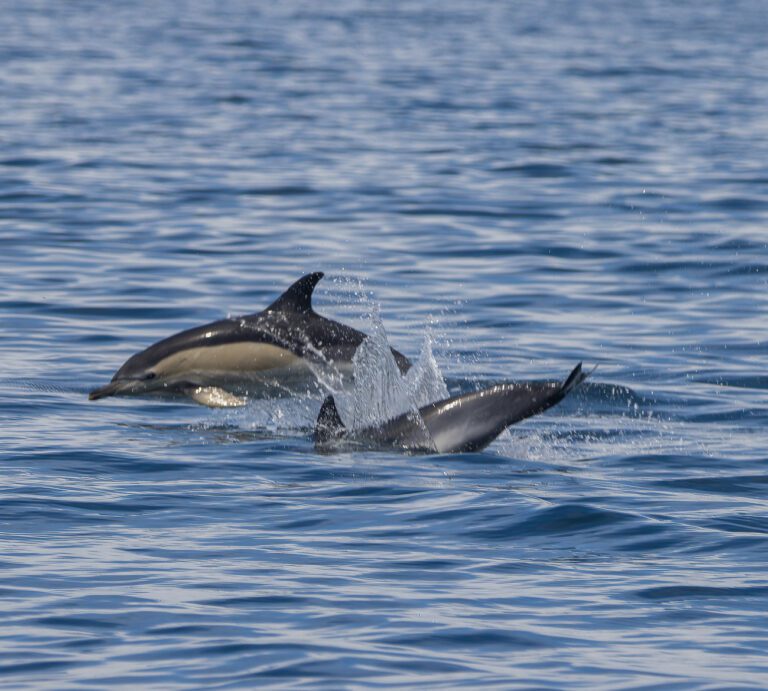Common dolphins live in pods of around 20 here in UK waters. They inhabit the deep offshore waters off our coastline and, lucky for us, are frequently seen just off Padstow. They are very sociable creatures, enjoying bow riding and interacting with boats.
As their name suggests, the dolphin you will most likely encounter is the Common Dolphin. Common Dolphins live in pods of around 20 and are extremely inquisitive characters. Because of their sociable nature, these dolphins tend to interact with the boats a lot more, giving you an up-close view of their beautiful pod. The Common Dolphin may be easier for you to spot: they can often be seen in their pods following the boats or you’ll see them jumping out of the water as they swim. They have a very distinctive yellow and grey ‘hourglass’ pattern along their sides. Lucky for us, they like the deep waters off the Cornish coast, particularly just outside of Padstow!
Share with a friend:

Dolphins produce bubbles to herd their prey to the surface and then hit the fish with their tail to stun them, this technique is called ‘fish-wacking’

Book a boat trip to be in with a chance of spotting these amazing animals. Common dolphins can be seen at any time of year around Cornwall and can be spotted from headlands, but to encounter them up close is a whole different experience. Our boat trips are an unforgettable adventure, where you can see some amazing scenery as we search for an array of sealife.
Yes, dolphins are mammals, specifically marine mammals. This means that they are warm blooded, child bearing aquatic creatures. However unlike land mammals, aquatic mammals like dolphins and whales have a seperate breathing and food passage. This stops them from drowning when hunting and eating their prey. Because of this dolphins don’t actually possess vocal cords and instead uses their nasal passage to produce the distinctive clicks and whistles.
The earliest records of dolphins can be traced back as far as 10 million years. So they’ve been around for a while! Their closest relatives – the whales are even older, existing as far back as 40 million years ago, they lived on land before slowly evolving into the marine mammals we know today. Looking in to the past makes it easier to understand why these exclusively aquatic animals are mammals.
Almost everywhere! Dolphins live in all oceans of the planet and even in some rivers too. There are 39 types of cceanic dolphins and 5 river dolphin so with 44 different species there’s almost a dolphin for every oceanic environment. One of the best known dolphin (the bottlenose) lives in every ocean in the world – bar the arctic and antarctic.
Most dolphins live in the shallow waters, on the ocean’s continental shelves. Needing to come up for air means they don’t often go into the deep ocean, but some of the larger species do venture further out.
They aren’t too picky. Being predators dolphins have to hunt for their food and on average need to eat between 4-9% of their body weight in fish per day. Their diets depend mostly on where they are. In Cornwall dolphins predominantly eat fish like herring, cod or mackerel but may also eat squid or other cephalopods. The largest member of the dolphin family, the killer whale may eat marine mammals like seals or sea lions – sometimes even turtles! Dolphins use several methods to catch their prey: Herding: This is a cooperative hunt performed by a pod. Splitting into two, one group surrounds a school of fish while the other group take turns to eat through the compacted school of fish.
Corraling: The Dolphins trap fish in shallow waters.
Killer Whales: When killer whales hunt marine mammals they tend to use their tails to hit them in the water or throw them, stunning them enough to make a fatal blow.
Dolphins do sleep but not like land mammals. When it’s time to sleep the dolphin will shut down one hemisphere of it’s brain and close the opposite eye and will alternate this throughout its ‘sleep’. The side of the brain that’s awake monitors the environment and controls breathing. There are three main reasons why they do this:
This type of sleep allows them to keep moving constantly which helps the warm blooded dolphin to maintain a constant heat.
To look out for danger and predators.
If they were fully unconscious they would likely drown because they have to be constantly holding their breath while underwater.
Depending on the species, dolphins can live up to 90+ years. Although in captivity these tend to be more than halved. Smaller dolphin species will live an average of 25 – 30 years, but killer whales have a 40 – 60 year lifespan, with some even estimated to live for over 90 years. Meanwhile, captive killer whales have an average lifespan of 25 years or less. This shows the best place for them to be is wild and free.
Some are. The Māui’s dolphin, found in the waters of New Zealand, is on the brink of extinction due to the masses of discarded fishing gear (ghost gear) with estimates suggesting less than 100 of these dolphins remain in existence. No dolphins in Cornish waters are on the endangered list, however they are still at risk of entanglement in fishing gear.
A group of dolphins is called a pod. These are normally made up of around 12 dolphins. However, with an abundance of food, they can reach up to 1000 individuals – this is called a superpod.
Padstow Sealife Safaris give you the chance to get up close and personal with these fascinating creatures. Depending on the time of year that you choose to visit, you’ll have the chance to see a number of different species.